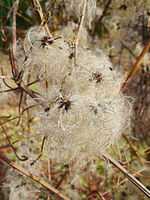Clematis vitalba
| Clematis vitalba | |
|---|---|
.jpg) | |
| The silky appendages of the fruits | |
| Scientific classification | |
| Kingdom: | Plantae |
| (unranked): | Angiosperms |
| (unranked): | Eudicots |
| Order: | Ranunculales |
| Family: | Ranunculaceae |
| Genus: | Clematis |
| Species: | C. vitalba |
| Binomial name | |
| Clematis vitalba L. | |
Clematis vitalba (also known as Old man's beard and Traveller's Joy) is a shrub of the Ranunculaceae family.
Description
Clematis vitalba is a climbing shrub with branched, grooved stems, deciduous leaves, and scented greeny-white flowers with fluffy underlying sepals. The many fruits formed in each inflorescence have long silky appendages which, seen together, give the characteristic appearance of Old Man's beard. The grooves along the stems of C. vitalba can easily be felt when handling the plant.
The flowers of this species are eaten by the larvae of moths including The V-Pug and Double-striped Pug and the leaves by Willow Beauty.
Range
C. vitalba has a preference for base rich alkaline soils and moist climate with warm summers
United Kingdom
In the UK it is a native plant and is and common throughout England south of a line from the River Mersey and the River Humber. It also commonly occurs in southern, Eastern and northern Wales. Outside of these areas it is widely planted and occurs as far north as the southern highlands of Scotland.[1]
Characteristics
- Reproductive organs:
- Inflorescence type: biparous cyme
- Sex: hermaphrodite
- Type of pollination: entomophilous
- Seed:
- Type of fruit: achene
- Dissemination: With the wind
- Habitat and distribution:
- Type of habitat: Mid-European shrubberies, mountainsides, in moderately eutrophic regions
- Distribution: Holarctic
Invasiveness
Due to its disseminatory reproductive system, vitality, and climbing behavior, Clematis vitalba is an invasive plant in most places, included many in which it is native. Some new tree plantations can be suffocated by a thick layer of Clematis vitalba, if not checked. [2]
- New Zealand
In New Zealand it is declared an "unwanted organism" and is listed in the National Pest Plant Accord. It cannot be sold, propagated or distributed. It is a potential threat to native plants since it grows vigorously and forms a canopy which smothers all other plants and has no natural controlling organisms in New Zealand. New Zealand native species of Clematis have smooth stems and can easily be differentiated from C. vitalba by touch.
Use
Clematis vitalba was used to make rope during the Stone Age in Switzerland.[3] In Slovenia, the stems of the plant were used for weaving baskets for onions and also for binding crops.[4] It was particularly useful for binding sheaves of grain because mice do not gnaw on it.[5]
Images
 Flowers |
 Close-up of a flower |
 Leaves |
 Fruits |
References
- ↑ New Atlas of the British and Irish Flora
- ↑ Invasive Species Compendium. "Clematis vitalba". Retrieved October 2011.
- ↑ Johnson, Magnus. 2001. The genus Clematis. Södertälje: Magnus Johnsons Plantskola AB, p. 37.
- ↑ Petauer, Tomaž. 1993. Leksikon rastlinskih bogastev. Ljubljana: Tehniška založba Slovenije, p. 139.
- ↑ Kržan, Vanja. 2010. "Mi pa oznanjamo Kristusa, križanega (1 Kor 1,23)." Zaveza 42 (25 February). (Slovene)
External links
| Wikimedia Commons has media related to Clematis vitalba. |
- Global Invasive Species Database - Clematis vitalba
- Traveller's Joy at Bioimages.org
- Traveller's Joy by Regional Burgas Museum Clematis vitalba in Bulgaria